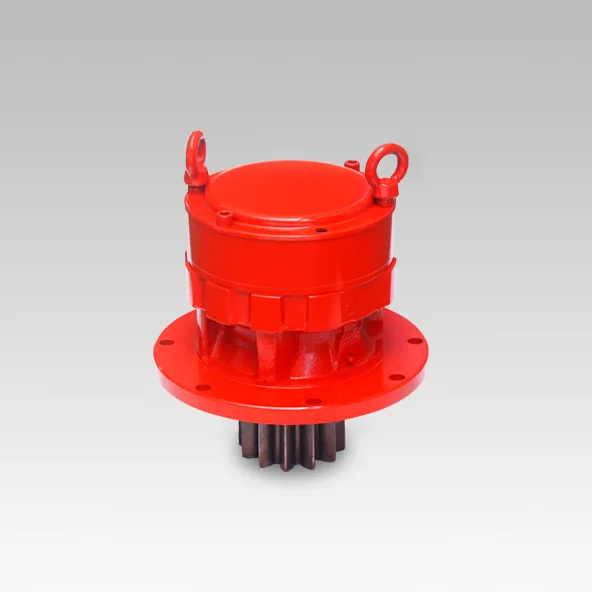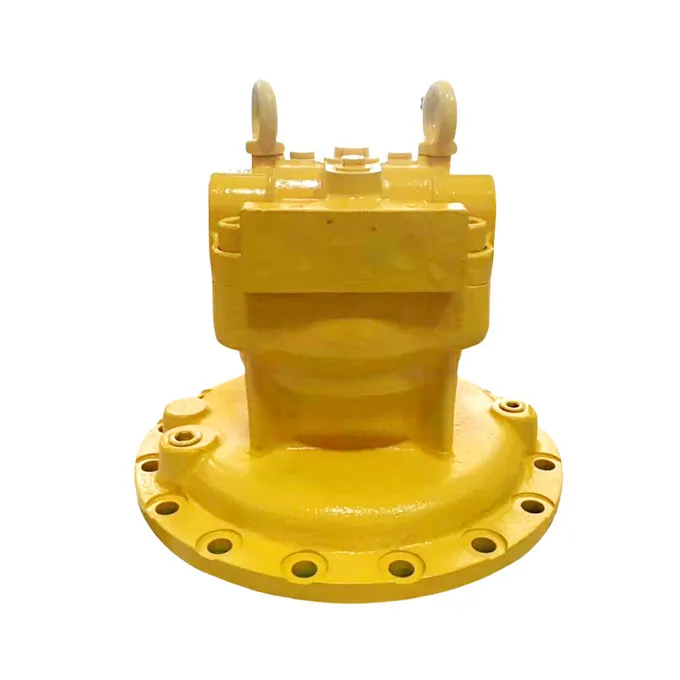
Understanding the costs associated with an svingmotor for gravemaskin is essential for budgeting and ensuring optimal operational efficiency. This blog will explore various factors influencing the cost, types of swing motors, maintenance expenses, and tips for making cost-effective decisions.
A swing motor, also known as a slewing motor, is a crucial component of an excavator that provides the necessary rotational force to swing the upper structure. It converts hydraulic or electric power into mechanical movement, enabling the excavator to perform tasks efficiently. Essentially, the swing motor allows the excavator to rotate its house, which includes the cab, boom, and attachment, around its undercarriage. This rotation is what gives an excavator its versatility in digging, lifting, and positioning materials. Without a swing motor, an excavator would be severely limited in its ability to navigate a worksite and complete tasks effectively.
Swing motors play a vital role in enhancing the maneuverability and versatility of excavators. They are essential for tasks that require precise positioning, such as digging, lifting, and placing materials. The ability to rotate the upper structure allows operators to work in confined spaces and handle materials from different angles without repositioning the entire machine. This not only increases productivity but also reduces the time and effort required to complete tasks. Without a functional swing motor, the excavator’s performance would be significantly hindered, leading to delays and increased operational costs.
Swing motors typically consist of several key components, including the motor itself, gears, bearings, and seals. These components work together to ensure smooth and efficient rotational movement. The motor generates the power needed for rotation, which is then transferred through gears to increase torque and control speed. Bearings support the rotating parts and reduce friction, while seals prevent contaminants from entering the motor and causing damage. Understanding these parts can help in identifying potential issues and maintaining the motor effectively. Regular inspection and maintenance of these components are crucial to ensure the longevity and reliability of the swing motor.

The type of swing motor you choose can significantly impact its cost. There are mainly two types of swing motors: hydraulic and electric. Each type has its advantages and drawbacks, which can affect their pricing.
Hydraulic swing motors are the most common type used in excavators. They are known for their high torque output and durability. Hydraulic motors utilize hydraulic fluid to generate the necessary force for rotation, making them highly efficient for heavy-duty applications. However, they can be more expensive to maintain due to potential leaks and the need for regular fluid checks. Over time, seals and hoses may wear out, requiring replacement to prevent fluid loss and maintain optimal performance. Despite these maintenance requirements, hydraulic swing motors are preferred for their reliability and ability to handle demanding tasks.
Electric swing motors are becoming increasingly popular due to their energy efficiency and environmental benefits. These motors use electric power to generate rotational force, making them a cleaner alternative to hydraulic motors. While they may have a higher upfront cost, their lower maintenance requirements and precise control can offer long-term savings. Electric motors do not require hydraulic fluid, reducing the risk of leaks and the need for regular fluid checks. Additionally, they produce less noise and emissions, making them suitable for use in environmentally sensitive areas. However, it’s important to consider the availability of a reliable power source and potential limitations in torque compared to hydraulic motors.
The brand and manufacturer of the swing motor can also influence its cost. Well-known brands with a reputation for quality and reliability may charge higher prices. These brands often use high-quality materials and advanced manufacturing processes to ensure their products meet industry standards and perform consistently. Investing in a reputable brand can provide peace of mind and reduce the likelihood of frequent repairs or replacements. Additionally, established brands often offer better customer support and warranty options, which can be valuable in case of any issues or defects. However, it’s essential to balance the cost with the specific requirements of your excavator and project.
The specifications and features of the swing motor, such as torque capacity, speed, and additional functionalities, can affect its cost. High-performance motors with advanced features may come at a premium price but can offer enhanced efficiency and longevity. For instance, motors with higher torque capacity can handle heavier loads and more demanding tasks, while those with variable speed control can provide more precise operation. Additional features such as integrated sensors for monitoring performance and diagnostics can also add to the cost but offer benefits in terms of maintenance and troubleshooting. It’s important to assess your specific needs and project requirements to determine the most suitable motor specifications.
Deciding between a new or used swing motor can also impact the cost. New motors typically come with a warranty and the latest technology, ensuring optimal performance and reliability. However, they can be more expensive upfront. Used motors can be a cost-effective option if they are in good condition and have been properly maintained. It’s essential to carefully inspect used motors and consider factors such as wear and tear, remaining lifespan, and availability of spare parts. While used motors may offer initial savings, they may require more frequent repairs and maintenance, potentially offsetting the cost benefits. Evaluating the pros and cons of each option can help you make an informed decision.
The initial purchase cost of a swing motor is influenced by several factors, including the type, brand, and specifications. On average, the cost of a new hydraulic swing motor can range from $5,000 to $15,000, while electric swing motors may cost between $6,000 and $18,000. The specific price within this range depends on the motor’s torque capacity, speed, and additional features. For instance, a high-torque hydraulic motor designed for heavy-duty excavators will likely be on the higher end of the price range. It’s important to consider the long-term benefits and potential savings associated with higher-quality motors, as they can offer better performance and durability.
Installation costs should also be considered when budgeting for a swing motor. Professional installation ensures that the motor is correctly fitted and functioning optimally. Installation costs can vary depending on the complexity of the motor and the labor rates in your area, typically ranging from $500 to $2,000. Factors such as the type of excavator, accessibility of the installation site, and any additional modifications required can affect the installation cost. It’s advisable to work with experienced technicians who can handle the installation process efficiently and address any potential issues. Proper installation is crucial for ensuring the motor’s performance and longevity.
Regular maintenance and potential repairs are ongoing costs associated with swing motors. Maintenance costs can include fluid checks, lubrication, and inspections. Hydraulic motors require periodic fluid changes and checks to ensure optimal performance and prevent leaks. Electric motors may require less frequent maintenance but still need regular inspections to identify any wear and tear. Repair costs can vary depending on the severity of the issue and the availability of spare parts. Common repairs may include replacing worn-out seals, bearings, or gears. Budgeting for maintenance and repairs can help avoid unexpected expenses and ensure the swing motor operates efficiently and reliably.
Operating costs, such as energy consumption for electric swing motors and hydraulic fluid for hydraulic motors, should also be considered. While these costs may seem minor compared to initial purchase and maintenance, they can add up over time. Electric motors typically consume less energy and have lower operating costs, making them more cost-effective in the long run. However, the availability and cost of electricity in your area can impact the overall operating expenses. Hydraulic motors require regular fluid top-ups and may have higher operating costs due to fluid consumption and potential leaks. Assessing the long-term operating costs can help you make an informed decision and manage your budget effectively.
Regular maintenance is crucial for extending the lifespan of a swing motor and reducing the likelihood of costly repairs. Conducting routine inspections, lubrication, and fluid checks can help identify potential issues early and prevent them from escalating. For hydraulic motors, this includes checking for leaks, monitoring fluid levels, and replacing worn-out seals and hoses. Electric motors require periodic inspections to ensure electrical connections are secure and components are in good condition. Keeping a detailed maintenance log can help track maintenance activities and identify recurring issues. By addressing minor problems promptly, you can avoid more significant and expensive repairs in the future.
Selecting the right type and specifications of the swing motor for your specific needs can help optimize performance and reduce costs. Consider factors such as load capacity, rotation speed, and environmental conditions when choosing a motor. For heavy-duty applications, a hydraulic motor with high torque capacity may be more suitable, while electric motors can be ideal for projects requiring precise control and lower operating costs. Additionally, consider the motor’s compatibility with your excavator and any specific requirements for your project. Consulting with experts or manufacturers can provide valuable insights and help you make an informed decision that balances performance and cost.
While it may be tempting to opt for a cheaper swing motor, investing in a high-quality motor from a reputable brand can provide long-term savings. Quality motors are less likely to require frequent repairs or replacements, reducing overall costs. High-quality motors are built with durable materials and advanced engineering, ensuring they can withstand demanding conditions and perform reliably. Additionally, reputable brands often offer better warranties and customer support, providing added peace of mind. Although the initial investment may be higher, the long-term benefits of reduced downtime, maintenance, and repair costs can make it a cost-effective choice.
Proper training for operators and ensuring correct usage of the swing motor can also help reduce costs. Misuse or improper handling can lead to premature wear and tear, increasing the likelihood of expensive repairs. Providing operators with comprehensive training on the correct operation of the excavator and swing motor can prevent common mistakes and ensure efficient usage. This includes understanding the motor’s capabilities, following recommended operating procedures, and conducting regular inspections. Encouraging a culture of proactive maintenance and responsible operation can significantly extend the motor’s lifespan and reduce overall costs.
Understanding the cost of an excavator swing motor involves considering various factors, including the type of motor, brand, specifications, and additional expenses such as installation and maintenance. By making informed decisions and investing in quality, you can optimize the performance of your excavator and manage costs effectively. Regular maintenance and proper usage are key to extending the lifespan of the swing motor and ensuring efficient operation. Whether you choose a hydraulic or electric motor, it’s essential to balance initial costs with long-term benefits and prioritize quality and reliability. By following these tips and guidelines, you can make cost-effective decisions and maximize the value of your investment in an excavator swing motor.